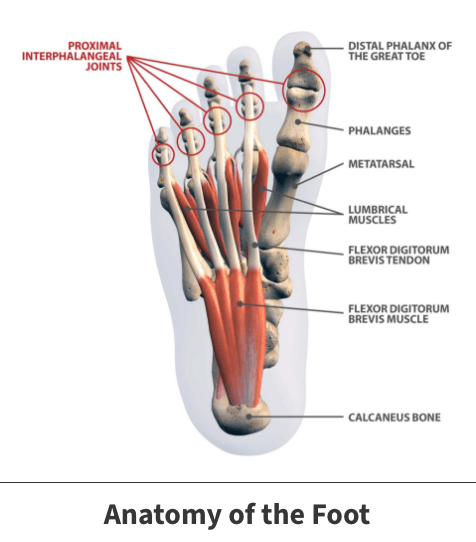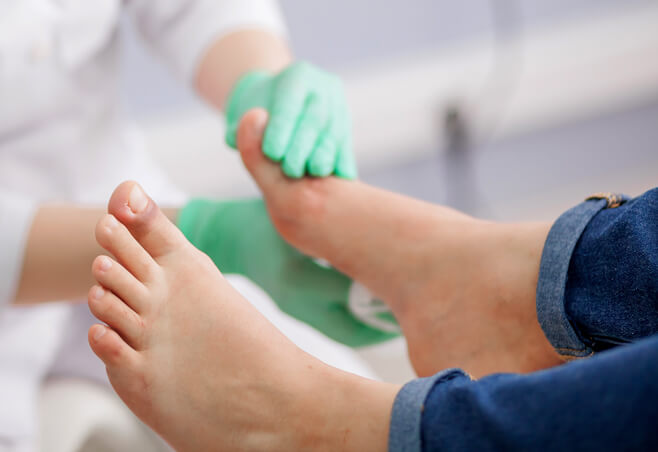Anatomy

Hammer toe impacts the second, third, and fourth toes. This issue occurs when the middle joint, known medically as the PIP, or the proximal interphalangeal joint, bends inward. This abnormal movement makes the toe look like a hammer, which describes the condition’s name.
About
Hammer toe is a common foot condition with more than 200,000 cases in the United States every year. The toe has an abnormal bend in the middle joint, causing it to bend or curl downward instead of pointing forward. Hammer toe most commonly affects the second or third toe.
Causes
Researchers believe that the condition’s root cause is a foot muscle imbalance resulting in excessive pressure placed on a toe’s soft tissues like ligaments and tendons. Wearing improper footwear is usually the most significant contributing factor.
This is particularly true of dress shoes like high heels. The foot’s pathway grows narrower in this type of shoe, which causes the middle toes to bend inward more than they are used to. This bending is only heightened when individuals walk because these shoes have such strong heel force.
When you wear high heels or only wear them a few times, foot muscles compensate by straightening the affected toes. But as the shoes are worn more often, the muscles weaken and grow less capable of performing the corrective action. The result is the onset of hammer toe.
Symptoms
The most obvious symptom is the bending of the affected toe.
This physical problem is also often accompanied by other occurrences, including:
- Toe pain
- Discomfort that worsens when you move the toe or puts shoes on
- Difficulty walking
- Trouble standing or bearing weight on the injured toe and foot
The damaged toe can develop painful growths like corns or calluses. They can intensify pain and other symptoms.

Diagnosis
Moderate to severe hammer toe is readily visible, which makes the condition somewhat easy to diagnose. Your physician will still move the affected toe to gauge its flexibility levels and help determine the most appropriate treatment.
In some cases, diagnostic imaging like X-rays may be required to complete the diagnosis. Occasionally, your physician might use various other diagnostic tools to rule out other conditions.
Treatment
Hammer toe is treatable, and it is simplest to address during its early to middle stages. Severe instances may need surgery.
Nonsurgical treatment options
The most direct remedy is the use of different footwear. Your physician will likely suggest that you refrain from wearing high heels or any other shoes that leave their toes little, if any, wiggle room. It is recommended that hammer toe sufferers wear footwear that is at least a half-inch longer than their big toe.
When a hammer toe takes hold, you can usually benefit from wearing shoes that help accommodate the problem. Shoe repair shops or specialty establishments may be able to extend a shoe’s length to fit the toe in question comfortably.
Over-the-counter aids
Items like cushions or orthotic devices placed inside shoes can make walking or exercising more pleasant and ease any associated discomfort.
Surgical procedures
In instances where you experience severe pain or mobility issues or the toe in question no longer moves, surgery may be required. The specific intervention a doctor recommends will depend on the condition’s severity. Commonly performed operations include:
- Tendon transfer – During this procedure, a surgeon transfers a healthy tendon from the top of the patient’s toe into the middle, which can help straighten the hammer toe.
- Tendon lightening – This surgery extends the tendons responsible for causing the joint abnormality in patients with flexible enough toe joints.
- Joint fusion – This operation, which is referred to as arthrodesis, is usually performed on persons with rigid joints and pronounced cases of hammer toe. Surgeons remove a tiny part of bone near the toe joint. This action enables the damaged toe to extend. During the second stage of this procedure, the surgeon inserts a metal plate, pin, or wire, into the bones connected to the affected joint. This enables the bones to eventually fuse together and keep the toe straight.
These procedures are typically performed on an outpatient basis. The full recovery period usually takes somewhere between four to six weeks.
Prevention
Not all incidents of hammer toe can be prevented. But some cases can be stopped or slowed in provided people:
- Wear appropriate footwear – If you are required to wear high heels, you should wear wider, more comfortable shoes.
- Exercise – Toe-strengthening exercises may prevent or reduce the chance of developing the condition. Specific movements, including curls, extensions, and splaying, often provide long-term benefits.
Videos
Related specialties
- Achilles Calcific Tendinitis
- Achilles Tendon Rupture
- Achilles Tendonitis
- Ankle Fracture Surgery
- Ankle Fractures (Broken Ankle)
- Ankle Fusion Surgery
- Arthroscopic Articular Cartilage Repair
- Arthroscopy of the Ankle
- Bunions
- Charcot Joint
- Common Foot Fractures in Athletes
- Foot Stress Fractures
- Hallux Rigidus Surgery - Cheilectomy
- High Ankle Sprain (Syndesmosis Ligament Injury)
- Intraarticular Calcaneal Fracture
- Lisfranc Injuries
- Mallet, Hammer & Claw Toes
- Metatarsalgia
- Neuromas (Foot)
- Plantar Fasciitis
- Sprained Ankle
- Total Ankle Replacement
- Turf Toe
